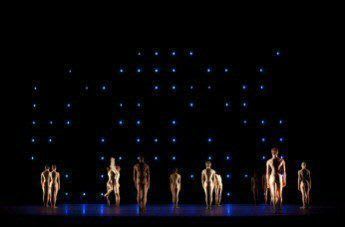The Royal Opera House was not full on the second night of its new triple bill. Too daring, too intellectual, or too difficult? But all credit to Monica Mason for her confidence. Balanchine, Tetley and McGregor make interesting bedfellows (last November McGregor's Infra was matched with fellow crossover choreographer Tetley's Voluntaries in a triple bill), but it's Balanchine's choreography that wins the contest hands down here.
Agon (from the Greek for contest), a 'concerto for dance' created in 1957 for tall, long-limbed athletic American dancers, looks a little ragged on the twelve variously sized Royal Ballet dancers, but there are cast changes due to illness. Tiny Yuhui Ohue (lovely arms), Ivan Putrov and Eric Underwood give good dance, and Natalie Harrison, replacing Melissa Hamilton, at least has the long legs, if not the speed. Hands flick, shoulders shimmy, legs flash like lightening. There's speed and gentle adagio, dynamic formations and gravity defying balances.
Balanchine's abstract choreography for twelve dancers, four men and eight women, musical ciphers, demonstrates Stravinsky's extreme harmonies and discordant tensions. The solos, pas de deux, de trois, and quatre variations mirror exactly Stravinsky's musical arrangement and grouping - he had recently moved to twelve-note serialism.
He also wrote an outline of the action into his score. There's an amazing synchronicity between composer and choreographer - an intimate language given dazzling display. Stravinsky commented that Balanchine's choreography made him see his music (not unlike Mark Morris then), but it proved to be the last time Stravinsky composed for ballet.
Tetley's 1977 Sphinx is new to the Royal Ballet, and this its second performance, so all praise to Marianela Nuñez (Sphinx), Rupert Pennefather (Oedipus), and Edward Watson (Anubis) for making sense of it. A narrative inspired by Cocteau's play, La Machine Infernale, a reworking of Sophocles, is given portentous weight by Bohuslav Martinu's dramatic double concerto for two string orchestras, piano and timpani, full of sadness, intense emotion, and tragedy.
The Sphinx gives up all for love of Oedipus and dies. Anubis, the Egyptian jackal-headed god of death, warns her against falling for a mortal, but she is tired of immortality.
The choreography is exacting with arduous lifts for Oedipus. He raises the Sphinx on to his shoulders, she curls her body around his head, and then falling unfurls across his knee. At the end the Sphinx, energy spent, has to climb up on to her golden winged dais (Rouben Ter-Arutunian's faux-Egyptian design). At least the costumes by Willa Kim are simple - unitards, silver for the Sphinx, red for Anubis, flesh for Oedipus, masculine musculature outlined in contrasting ribbing.
McGregor's new piece, Limen, reaches for the sun and the moon, for "the idea of liminality, thresholds of darkness and light, presence and absence, life and death". Ambition doesn't come bigger than that. But it's an unfeeling autistic physically compromised universe.
The dancers rise to the challenge, of course - there is pleasure in exploring the new, in seeing how far one can push the body. Leanne Benjamin, Yuhui Ohue, Steven McRae, Edward Watson, Sarah Lamb, Marianela Nuñez, Mara Galeazzi, Eric Underwood and Melissa Hamilton give their all. Underwood and Lamb repeat the partnering and lifts (Lamb folds easily like paper) that so astonished in McGregor's Infra. And we realise that McGregor's works are head-banging variations on the same theme. Simian inelegance coupled with cybernetic speed and precision.
Starting at the jutting forward head, the movement ripples into a pigeon breast, into a sway back, a protruding bottom, and then back up again through a hyper-inflected pelvis - a salute to the sun, or a Max Wall funny walk - but the arms and legs are pistons. It's this unexpectedness that makes McGregor's work exciting: deformation, contortion, impossible angles, double bluffs, counterpoint, and the subjecting of bodies to extremes.
Inspired by Kaija Saariaho's 2007 cello concerto Notes on Light, McGregor has turned to visual artist Tatsuo Miyajima and his blue LED computer graphic installations of floating numbers and grid lights against which the human figure appears to disappear, for his continuing choreographic journey into new cognitive states.
Moritz Junge's costumes and Lucy Carter's lighting complement Miyajima's spectacular installations, and Anssi Kartunnen's solo cello contours the dance. TS Eliot's The Waste Land is quoted on the last page of Saariaho's score There is a clinical heartlessness at the heart of Limen, bereft of human warmth and spirit.
In rep till 18 November
